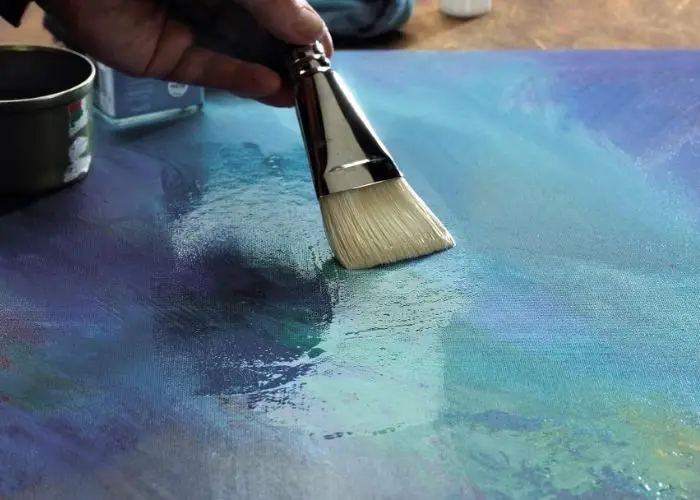If you’re an artist, you know how important it is to protect your paintings. Acrylic paintings can be very delicate, and if they’re not properly protected, they can easily become damaged.
In this blog post, we will discuss some tips on how to protect your acrylic paintings on canvas. We’ll also talk about how to clean them and store them safely.
So if you’re interested in learning more about how to protect acrylic paintings on canvas, keep reading!
How to Protect Acrylic Paintings on Canvas
- Prime your canvas before painting
- After painting, apply an isolation coat
- Use a UV-resistant varnish on the painting
- Keep the painting away from high humidity levels
- Hang the painting in a room that doesn’t get direct sunlight
Why Do We Need to Protect Acrylic Paintings?
Acrylic paintings are made with pigments that are suspended in a polymer emulsion. This makes them different from oil paintings, which use drying oils to bind the pigments together.
Because of this, acrylic paintings are much more delicate and can be easily damaged if they’re not properly protected.
One of the most important things you can do to protect acrylic paint on canvas is to prime the surface before you start painting.
This will create a barrier between the paint and the canvas, and it will also help prevent the acrylic paint from becoming absorbed into the canvas.
After you’ve finished painting, you should also apply an isolation coat. This isolation coat will protect the painting from dirt, dust, and other environmental contaminants.
It is typical for isolation coats to be mixed with Golden Soft Gel Gloss and water in equal measurements.
Finally, you should use a UV-resistant varnish such as Krylon K01305 on the painting. This will help to protect the colors from fading over time.
Where Should I Store My Acrylic Painting?

You should store your acrylic painting in a cool, dry place. Ideally, the room should be temperature-controlled and have low humidity levels.
You should also Hang the painting in a room that doesn’t get direct sunlight, as this can cause the colors to fade over time.
How Often Should I Clean My Acrylic Painting?
You should clean your acrylic painting every few months or whenever it starts to look dirty. You can use a soft cloth or a mild soap and water solution to clean the painting.
Avoid using harsh chemicals or abrasive cleaners, as these can damage the painting.
How to Protect Acrylic Paintings on Canvas
By following these tips, you can help to ensure that your acrylic paintings will be protected from damage.
Step 1: Prime canvas before painting
The first step to protecting canvas paintings is to prime the surface before painting.
This creates a barrier between the paint and the canvas, helping to prevent the paint from becoming absorbed.
If you’re using raw canvas, consider priming it with gesso. Gesso is a type of primer specifically designed for use with raw canvas, and it should be applied in 1-3 thin layers.
We recommend using U.S. Art Supply White Gesso Acrylic Medium.
Read: Easy black canvas painting ideas
Step 2: Apply an isolation coat for acrylic painting
After you’ve finished painting, apply an isolation coat to the surface. This isolation coat will protect the painting from dirt, dust, and other environmental contaminants.
You can find isolation coats at most art supply stores. A good sealer is crucial for protecting your paintings, so choose a high-quality isolation coat.
We recommend the Golden Artist Colors Isolation Coat because it protects and unifies the surface with or without the varnish.
Here is how to layer acrylic paint on canvas.
Step 3: Use a UV-resistant varnish on the painting
Use a UV-resistant varnish to protect your paintings from fading or other damage.
Varnishes come in two types, gloss varnish and matte finishes, so you can choose the one best suits your painting.
Use an acrylic resin varnish such as Sargent Art 32 Ounce Acrylic Gloss and Varnish for a glossier finish.
Apply the varnish in thin, even coats and allow it to dry completely before displaying or storing the painting.
Step 4: Store in a cool, dry place away from direct sunlight
Finally, store your paintings in a cool, dry place away from direct sunlight.
Temperature and humidity fluctuations can damage paintings, so it’s important to find a temperature-controlled storage spot with low humidity levels.
Hanging paintings in rooms that get direct sunlight will cause the colors to fade over time, so avoid placing them in bright areas.
Step 5: Clean every few months with a soft cloth or mild soap and water
To keep your paintings looking their best, clean them every few months with a soft cloth or mild soap and water solution.
Avoid using harsh chemicals or abrasive cleaners, as these can damage the painting. If you take proper care of your paintings, they will last for many years.
How to Varnish an Acrylic Painting

Varnishing is a great way to protect your paintings from dirt, dust, and other environmental contaminants. It also helps to prevent the colors from fading over time.
Varnishes come in glossy and matte finish, so you can choose the one best suits your painting.
Then, apply the varnish in thin, even coats and allow it to dry completely before displaying or storing the painting.
When should I varnish my painting?
You should apply a varnish sealer to your painting after it is completely dry.
Varnishing too soon can cause the paint to become tacky, which will make it more difficult to apply the varnish evenly.
How many coats of varnish should I use?
You should apply two to three coats of removable varnish to your painting. Allow each varnish coat to dry completely before applying the next.
Do I need to remove the old varnish before applying a new one?
Yes, you should remove the old varnish before applying a new one. To do this, use a solvent such as mineral spirits or turpentine.
Apply the solvent to a clean cloth and gently rub it over the surface of the painting until the old varnish is removed.
Once the old varnish is gone, you can apply a new coat. You’ll want to use a mineral spirit acrylic varnish for the new coat.
How to Protect the Acrylic Painting with MinWax Protective Finish
Minwax is a popular brand of protective finish that can be used on acrylic paintings.
This product comes in both spray and brush-on versions, so you can choose the one that best suits your needs.
Apply the MinWax Protective Finish in thin, even coats and allow it to dry completely before displaying or storing the painting.
You should apply two to three coats of this product with a wide base coat brush for the best results.
How to Use Household Items to Protect Your Painting
A few household items can be used to protect your paintings from damage. Glass is a great way to protect a painting from dirt, dust, and other environmental contaminants.
You can also use picture frames or mats to help keep your paintings clean.
Finally, consider hanging your paintings in rooms that don’t get direct sunlight to prevent the colors from fading over time.
The Best Ways to Care for, Clean, and Store Art

- Dust your acrylic painting with a feather duster to keep it clean. If the painting is very dirty, you can lightly dampen a rag with water and gently wipe the surface of the painting. Be sure to use mild soap if the painting is very dirty. Rinse the soap off with clean water and dry the painting with a soft towel.
- Avoid touching your canvas painting with your fingers; the natural oils on your skin can damage the paint. If you must touch the painting, be sure to wear gloves.
- To remove fingerprints or smudges, use a soft eraser. Gently rub the eraser over the area until the fingerprint or smudge is gone. Be careful not to rub too hard, as this can damage the paint.
- If you notice any cracks in the paint, don’t try to fix them yourself. Instead, take the painting to a professional for repair.
- Cover your painting in glass, so it’s in a protective frame. This will also help to keep the painting from getting dirty.
- Hang your paintings in rooms that don’t get direct sunlight. The sunlight can cause the colours to fade over time.
- Store your paintings in a cool, dry place.
Read More: How to Fix Chunky Paint on Canvas
FAQs
How do you seal an acrylic painting on canvas?
To seal an acrylic painting on canvas, you can use a spray varnish or a protective finish. Spray varnishes come in glossy and matte finishes, so you can choose the one best suits your painting. Then, apply the varnish and isolation coat in thin, even coats and allow it to dry completely before displaying or storing the painting.
What should I seal my acrylic painting with?
Spray varnish is the finest sealer for acrylic painting. Varnishes come in a variety of glossy and matte varnish, so you may select the one that best complements your work. Hairspray can also be used as a sealer for an acrylic painting. Hairspray is not as durable as a varnish, but it can provide a temporary seal until you are able to apply a varnish. You can also use a clear acrylic sealer. This type of sealer will not change the appearance of your painting and will provide a durable layer of protection.
How do you keep acrylic paint from cracking on canvas?
To prevent your acrylic paint from cracking, you should apply a varnish or a protective finish after the painting is dry. Varnishes and finishes form a protective layer over the painting that will help to prevent cracks. Apply the varnish or finish in thin, even coats and allow it to dry completely before displaying or storing the painting.
How do you waterproof an acrylic painting?
To waterproof your acrylic painting, you can use a clear sealer. This type of sealer will not change the appearance of your painting and will provide a durable layer of protection.
Do acrylic paintings on canvas need to be sealed?
Acrylic paintings on canvas should, in fact, be sealed. This is because the painting would be more resilient to damage if sealed. Use a removable varnish or a transparent sealer to seal your work of art.
How do you protect a canvas painting?
There are several methods to preserve a canvas work of art. The painting can be framed, for example. To keep your paintings clean, consider using picture frames or mats. Also, to prevent the colors from fading over time, hang your pieces in rooms that don’t receive direct sunlight.
How to protect acrylic painting on paper
Acrylic paintings on paper should be sealed with a transparent acrylic sealer. This kind of sealer will not alter the color of your artwork and will provide a durable layer of protection. You may also frame your work to keep it safe from harm. To preserve the colors in your painting, hang it in a location that doesn’t receive direct.
How to protect acrylic painting on wood
Acrylic art on wood may be preserved in a variety of fashions. For example, the painting can be sealed with a transparent acrylic sealer, or it can be framed. Picture frames and mats might also assist in keeping your artwork dust-free.
Conclusion
Acrylic paintings on canvas are a beautiful addition to any home, but they need to be protected from external elements in order to last.
By following these simple tips, you can keep your paintings looking great for years to come.
Have you ever tried protecting your acrylic paintings with one of these methods? Let us know how it went in the comments!










Leave a Reply